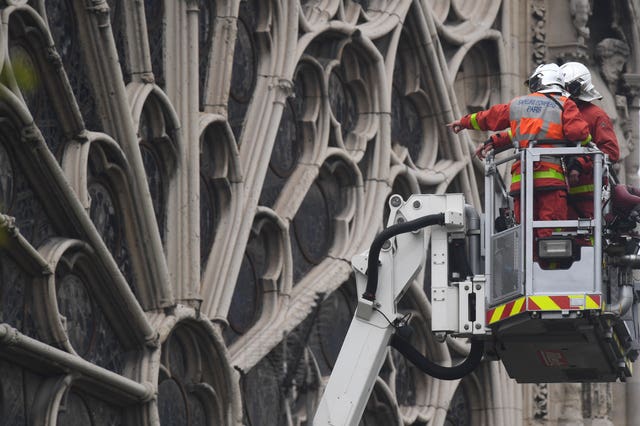
A modern restoration of Notre Dame would be the best use of the hundreds of millions of euros pledged for the immense project, rather than being “stuck with the past”, a leading expert on the cathedral has suggested.
Professor Stephen Murray, who co-led a project to laser map the Gothic masterpiece in minute detail, said the building was “revolutionary” for its day and the vast sums of money could be used for a cutting-edge update.
Notre Dame was within “15 to 30” minutes of complete destruction during the disastrous blaze that claimed the roof and spire, junior interior minister Laurent Nunez said.
Huge sums have been pledged to repair the beloved Paris landmark, which President Emmanuel Macron has set a target of five years to finish.
He said France “will rebuild Notre Dame Cathedral even more beautifully” as he addressed the nation little more than 24 hours after the devastating fire.
Asked if there should be a modern answer for the building’s restoration, Prof Murray said: “That’s what Gothic was all about”.
“The 12th-century cathedral of Notre Dame of Paris was the highest-tech vision of a building they could conceive,” he told the BBC’s World Tonight.
“It was really a revolutionary building and the roof was a revolutionary piece of carpentry and I don’t think we should be stuck with the past.
“We are children of the 21st century”.

Prof Murray, who studied at Oxford University and the University of London’s Courtauld Institute, co-led a project that used laser scanners and ultra-high-definition photography to document the building.
The expert on medieval art and Gothic architecture is now at Columbia University in New York.
He said the building’s exterior would stay “very much the same” and the interior vaults would be restored, but suggested the roof could be radically different.
Prof Murray said he expects the project to rebuild Notre Dame, which has received international offers of support, will unify France.
“Gothic architecture was very much about unifying a society in the great struggle to create something almost miraculous, and I suspect that’s something we are going to see now in the 21st century,” he said.
“Gothic architecture has been a way of bridging gaps and social divisions and silly arguments to pull people together to build something marvellous.”
Prof Murray’s scans, made several years ago with late art historian Andrew Tallon, could prove to be invaluable when rebuilding work begins.
But the immediate focus will be on securing the structure and salvaging what can be reused from the parts that crumbled in the blaze.
“Some of that material may be reusable, and that’s a painstaking exercise. It’s like an archaeological excavation,” Duncan Wilson, chief executive of Historic England, told AP.
Mr Macron announced a national subscription to help rebuild the monument as more than 600 million euros (£519 million) was pledged by firms and wealthy individuals.
Donors to the restoration project include French tycoon Bernard Arnault and his luxury goods group LVMH, pledging 200 million euro (£173 million) after a reported 100 million euro (£86 million) donation was promised by another French billionaire, Francois Pinault.
L’Oreal Group, the Bettencourt Meyers family and the Bettencourt Schueller Foundation jointly also pledged 200 million euro, while oil and gas company Total said it would give 100 million euro towards reconstructing the “architectural jewel”.
Fifty investigators are now working on a “long” and “complex” probe into the cause, Paris prosecutor Remy Heitz told reporters.
They will interview workers from five companies hired to work on renovations to the cathedral roof.
It is believed the blaze was an accident, possibly as a result of restoration work taking place.
At one point it was feared the cathedral would be completely destroyed in the blaze, which lasted more than 12 hours.
The tragedy prompted an outpouring of support internationally, with the Queen saying she was “deeply saddened” and Pope Francis offering his prayers.
Nous sommes ce peuple de bâtisseurs. Nous avons tant à reconstruire. Alors oui, nous rebâtirons la cathédrale Notre-Dame, plus belle encore, et je souhaite que cela soit achevé d’ici 5 années, nous le pouvons. Et là aussi nous mobiliserons.
— Emmanuel Macron (@EmmanuelMacron) April 16, 2019
The bells at Westminster Abbey tolled at 5.43pm on Tuesday afternoon – 24 hours after the fire started – and Prime Minister Theresa May announced bells at churches and cathedrals across England would ring in a further show of solidarity on Maundy Thursday.
She described images of the destruction as “truly heart-rending”, adding: “President Macron has pledged to rebuild the cathedral and I have conveyed to him that the UK will support this endeavour however we can.”
The cathedral housed a collection of valuable treasures, some which were salvaged and are due to be moved to the Louvre museum.
Speaking in front of the cathedral, junior interior minister Laurent Nunez said: “The task is – now the risk of fire has been put aside – about the building, how the structure will resist.”
Many Parisians spent Tuesday mourning viewing the destruction of one of the city’s most popular and admired landmarks.


Comments: Our rules
We want our comments to be a lively and valuable part of our community - a place where readers can debate and engage with the most important local issues. The ability to comment on our stories is a privilege, not a right, however, and that privilege may be withdrawn if it is abused or misused.
Please report any comments that break our rules.
Read the rules hereLast Updated:
Report this comment Cancel